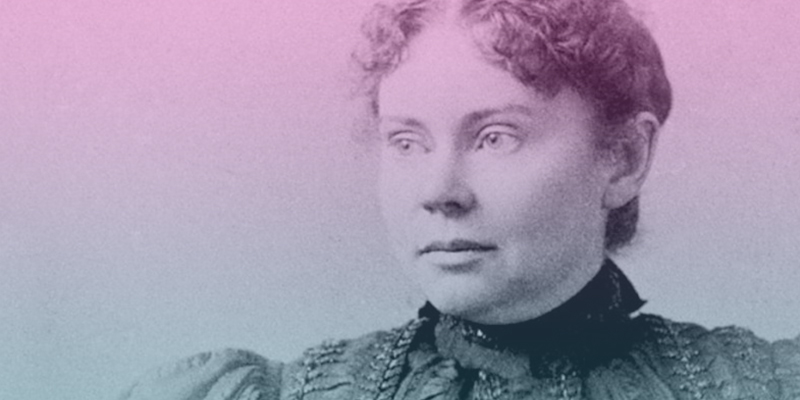When Lizzie Borden, in 1893, went on trial for the 1892 murders of her father and stepmother, Andrew and Abby Borden, few expected the story to capture the nation, or to spawn fictional take after fictional take in the years that followed. Cara Robertson’s new history of the Borden murders, The Trial of Lizzie Borden, declines to weigh in on the likelihood of Borden’s guilt—after all, there are far more interesting (and more verifiable) topics to explore, such as 19th century attitudes towards crime, the suffocating lives of women of a certain class, the fickle nature of Fall River Society, and the grand-standing speeches of a true “trial of the century.”
In her conclusion to the book, Robertson points out that the Borden murders have been used as a bellwether for American mores since they were first committed. Early concerns over class and gender gave way to new theories in the 20th century; popular explanations for why Lizzie might have committed the crimes ranged from period-induced madness (19th century), to romantic entanglements (early 20th century), to a lesbian murder pact (mid 20th century up to the present day), to avenging childhood sexual abuse (1990s), to mental illness or an attempt to gain financial security (present day). Whatever the true motivation for the murders, and whoever the true killer, the case continues to fascinate to this day. Cara Robertson was kind enough to answer a few questions about the book, the Borden case, and one of the most captivating trials in history.
Molly Odintz: Because of the book’s focus on the trial itself, rather than murders, you’re able to sidestep speculation about Borden’s guilt and dive into the context and public perceptions surrounding the case. What motivated you to focus on the trial?
Cara Robertson: I thought it offered a unique window onto the Gilded Age. Trials are especially revealing of a society’s codes: each side presents a narrative of events to a jury designed to represent the community at large and, in so doing, reveals what stories that community wants and expects to hear. Important public trials, like that of Lizzie Borden, are trials in which something larger than the fate of a particular defendant seems to be stake in the outcome.
You discuss in the book how Lizzie’s self-assured behavior clashed with the public’s perception of emotional female behavior—can you tell us a bit about why Lizzie’s behavior during the trial concerned some citizens and reassured others?
During the trial, many referred to Lizzie as a human sphinx, an unreadable cipher. Sympathetic journalists considered her self-possession a sign of ladylike bearing, a sort of inborn dignity that showed her innocence. Others saw it as proof of a decidedly unladylike sangfroid, a masculine nerve that seemed consistent with premeditated murder.
There’s much hubbub during the trial of the many women jockeying to get into the courtroom. Fast forward to a plethora of articles today wondering why women are so interested in the true crime boom. Why do you think society has such a hard time accepting that women will, and always have been, fascinated by true crimes?
 It’s a fascinating point. I think there was a sense that this was an important event and they should see it if possible, sort of like the World’s Fair that had just opened in Chicago. Here was a respectable woman accused of the most terrible crime imaginable, and the audience of women—a second jury—wanted to see the monster beneath the unflappable demeanor. In so doing, they became, in the eyes of the censorious journalists, monstrous themselves.
It’s a fascinating point. I think there was a sense that this was an important event and they should see it if possible, sort of like the World’s Fair that had just opened in Chicago. Here was a respectable woman accused of the most terrible crime imaginable, and the audience of women—a second jury—wanted to see the monster beneath the unflappable demeanor. In so doing, they became, in the eyes of the censorious journalists, monstrous themselves.
Julian Ralph, one of the reporters at the trial, noticed that Lizzie hid her face behind her fan during certain gruesome testimony, put forward by the prosecution. That was to be expected. But she followed equally gruesome testimony with avid interest when presented by her own team. He stepped back from the implications of this observation—that Lizzie might have been feigning horror when it suited her—and simply said it showed she was a woman (and women are like that). So even then there was an implicit acknowledgment that women were fascinated by grisly details.
Part of the fascination may arise from contemplating extreme violence from a safe distance. Homicide is predominately a male crime with male victims, yet women may have a disproportionate sense of vulnerability. When I think of the interest in serial killers, particularly charming sociopaths, I imagine the interest functions as an exercise in magical thinking. Looking at the gruesome details of true crime is a way to contain our anxiety and discern some kind of pattern as if it will ward off some comparable darkness from touching us directly.
One of the most fascinating aspects of the case is the class of the murderess, and how her life of leisure makes her both more and less of a suspect than her working class maid Bridget. Could you go into the class aspects of the trial a bit, and how threatening Lizzie’s potential guilt was for the growing cult of domesticity?
On the surface, Lizzie ticked all the boxes of proper middle class womanhood: she was from what was called a good family. Her father was rich and she had no need to earn a living. In keeping with the idea of separate spheres for men and women, she was active in good works, especially at her church, the only culturally sanctioned activity for a woman of her class. With her class status came a number of assumptions about her fundamental goodness, assumptions that were not accorded to Bridget Sullivan, an Irish immigrant of the working classes. So Lizzie Borden presented a conundrum that threatened the distinctions that shored up the social order, as for example, between the maid who might have been expected to know how to swing an ax and the mistress who would not.
The murders of Abby Durfee Borden and Andrew Borden are seen as male-coded in their extreme violence, yet there were counter theories that Lizzie could have been driven to extreme violence by being on her period. Can you talk a bit about the 19th century version of female criminality?
 By the late nineteenth century, earlier ideas of criminals as ordinary people who were unable to resist temptations gave way to the notion that criminals were born, not made, and that it was therefore possible to discern a criminal type based on physical characteristics. For example, Lizzie Borden’s oversized jaw might have been taken as a marker of criminality. At the same time, women were viewed as fundamentally different than men—biology was destiny—with profound disabilities from their menstrual cycles. The convergence of those two theories meant that the violent female criminal was a true monster. And Lizzie Borden did not look like one!
By the late nineteenth century, earlier ideas of criminals as ordinary people who were unable to resist temptations gave way to the notion that criminals were born, not made, and that it was therefore possible to discern a criminal type based on physical characteristics. For example, Lizzie Borden’s oversized jaw might have been taken as a marker of criminality. At the same time, women were viewed as fundamentally different than men—biology was destiny—with profound disabilities from their menstrual cycles. The convergence of those two theories meant that the violent female criminal was a true monster. And Lizzie Borden did not look like one!
Continuing on the same thread, there’s some fascinating and disturbing stuff in the book about the assumption of criminality by outsiders and immigrants. Unfortunately we don’t seem to have moved far beyond that in society today. What’s your takeaway from the Borden trial in the context of Trump’s America?
It is remarkable how tempting it is to project our fears onto outsiders and uncanny how closely the anxieties of the Gilded Age mirror our own.
There were a couple of key pieces of evidence that ended up not being allowed into the trial—do you think the jury’s opinion would have been different, had the issue of Lizzie’s alleged attempt to buy prussic acid been allowed into the debate?
Lizzie’s attempt to buy prussic acid would have shown she may have had murder on her mind and therefore punctured the defense contention that she was simply an innocent bystander in her own home, in the wrong place at the wrong time. Had the evidence been admitted, the defense would have pointed out that poisons have legitimate household uses—killing vermin, for example—and that might have been persuasive to the jury. On the other hand, unlike a hatchet, poison was considered a woman’s weapon. If Lizzie had tried and failed to procure a deadly poison, then that fact might have led the jury to wonder if she had turned to a readily available household implement to carry out a murderous plan.
Having said all that, I think the trial hinged on the question of whether a woman like Lizzie could have committed the murders. So I don’t think it would have made a difference to the verdict.
While plenty of folks have tried to insert a romantic element to the story, you seem to lean more towards the suffocating tension in the house between generations as the most plausible reason for Lizzie’s potential murders, which I completely agree with. Why do you think there’s been so many attempts to make Lizzie a romantic figure? Which of the recent fictionalized Lizzies gibes best with your knowledge of the historical figure?
Well, the story would be better if she cut a more glamorous figure, something the journalists noted at the time, reporting with some chagrin that she was actually quite plain. But the main reason to add a romantic element is to provide an appropriately feminine motive for the murders. A thwarted romance or a sinister lover would have helped make the case understandable. Indeed, adding that piece allowed an unscrupulous private detective to trick the Boston Globe into publishing a fake story in October 1892 alleging that Lizzie was pregnant and the father was her uncle John Morse. Without someone like that, we are left with the suffocating tension in the household and a desire for financial independence as motive. At the time, even the prosecutors couldn’t quite bring themselves to acknowledge the money motive, as if neither they nor the jury could believe that women could act in such a cold blooded way.
The recent film Lizzie (2018) is an effective portrait of an intelligent woman trapped in unbearable circumstances and, in that way, perhaps offers a way into the suffocating dynamics in the Borden household. It was the site of a cold war in which daughters and parents conducted their lives as separately as is possible—all within hearing and sight of each other. But it also piles on the motivations—her rapacious uncle wants her money; she has an illicit love for Bridget; she’s epileptic and could be committed to an asylum; and her father is very, very bad. I think it reflects our continuing discomfort with the idea that a seemingly normal woman, a woman who had led an unremarkable life, would kill to gain financial independence.
Emma Borden is a bit of a cipher in your book, and in the historiographical narrative, but you mention a fascinating alternative theory that Emma did it. Which of the many alternative theories do you think holds the most credence?
They are all interesting but none are supported by any real evidence.
While Lizzie was exonerated, she quickly faced isolation from her peers, and lived a long life in Fall River despised or ignored by her former supporters. What were her twilight years like?
On one level, it was the life she wanted. She and her sister moved to a grander house in the elite residential district of Fall River; she had her own money; she even attended the theater in Boston. There, she met a charismatic actress named Nance O’Neil sparking rumors of a relationship beyond mere friendship. It may have been that scandal—though there were also rumors about a handsome coachman—that may have sparked the rift with her sister Emma, who moved out in 1905 and never spoke to Lizzie again.
Lizzie took comfort in a succession of dogs for whom she built an elevated seat in her chauffeur driven car. She acted as “Auntie Borden” to the children of her domestic staff, taking them for ice cream and sending them special delivery birthday greetings. There is nothing in her later life to suggest she had any regrets.













